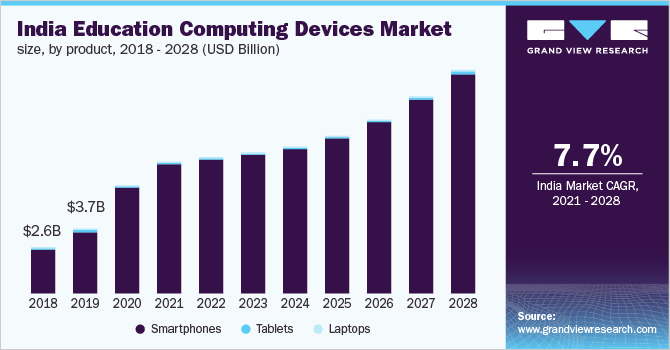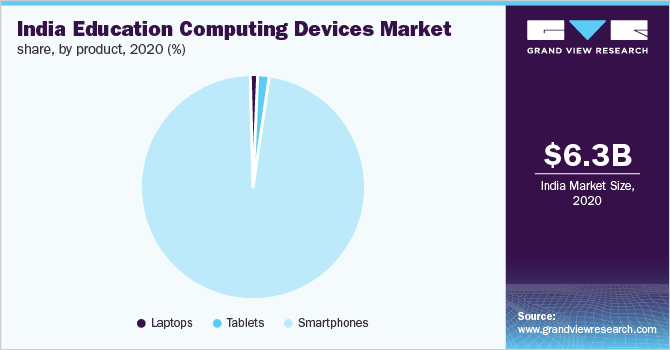- Home
- »
- Electronic Devices
- »
-
India Education Computing Devices Market Report, 2028GVR Report cover
![India Education Computing Devices Market Size, Share & Trends Report]()
India Education Computing Devices Market Size, Share & Trends Analysis Report By Product (Smartphones, Laptops, Tablets), And Segment Forecasts, 2021 - 2028
- Report ID: GVR-4-68039-692-8
- Number of Pages: 60
- Format: Electronic (PDF)
- Historical Range: 2017 - 2019
- Industry: Semiconductors & Electronics
Report Overview
The India education computing devices market size was valued at USD 6.3 billion in 2020 and is projected to expand at a compound annual growth rate (CAGR) of 7.7% from 2021 to 2028. Over 280 million students in India were impacted by the pandemic in 2020 and forced to transition to e-learning. However, with the huge disparity in terms of access to the internet and technology, the transition was a challenging one for most students as well as educators. The pandemic has necessitated the need to address the long-standing issue concerning the digital divide in India.

Although India offers lucrative opportunities for online education, the market growth is expected to be impacted by factors such as limited peer-to-peer engagement, poor digital infrastructure, language barriers in non-urban areas, poor internet connectivity, and frequent power cuts. In 2020, several students belonging to economically backward classes were forced to opt out of schools owing to the lack of technology to access digital learning. The economic disruption caused by the pandemic further added to the economic burden of underprivileged students, making it difficult for them to continue their education.
In India, computing devices for educational purposes are largely purchased by individual consumers rather than educational institutions procuring them for students. The pandemic has propelled the online learning trend among students between 12 and 18 years old, further contributing to the growth of the consumer device industry. In 2020, as educational institutes switched to e-learning, more than 70% of consumers preferred using a smartphone or tablet for online classes as opposed to making a new purchase. Hence, the demand for education computing devices remained moderate in the education sector.
The pandemic has served as an effective catalyst for the market in 2020. Most companies experienced a revenue decline in the first quarter of the year. The major impact on revenue was marked by the disruption in the supply chain and the closure of production units. Additionally, the shutdown of showrooms, warehouses, hypermarkets, and supermarkets also affected the market growth. However, the latter half of the year witnessed a high demand for computing devices, thereby propelling the overall year-on-year growth.
The India education computing devices market is expected to further witness growth as schools and other educational institutions continue to remain shut. Many companies are still receiving contracts and orders, which is anticipated to provide impetus to the market growth in the long run. For instance, in December 2020, Lenovo received a contract from the Government of Tamil Nadu to offer 15 lakh laptops under the Free Laptop Scheme.
Product Insights
In India, smartphones witnessed the highest demand for educational purposes, accounting for over 85% of the overall volume share in 2020. Post pandemic, online learning is expected to become mainstream in the Indian education system and would no longer be considered as an alternative to traditional schooling. However, there is a vast digital divide in the country, primarily due to the affordability factor associated with devices that enable online education.
Over 80% of children in India are deprived of internet connectivity. Moreover, the country’s smartphone penetration was only approximately 25% as of 2020. This suggests that the growth of online education in India is dreary. However, since smartphones are the most economical option for online education, students from government-aided schools and institutions are widely adopting smartphones. Therefore, smartphones accounted for the largest share of the overall educational device sales in India. As of 2020, over 70% of Indian students used smartphones as many could not afford a tablet or a laptop.

The sale of laptops for education in India surpassed 100K units in 2020, registering a year-on-year growth of over 150% from 2019 to 2020. The report scope covers the sale of laptops for the age group 4-18 years, primarily focusing on schools. As schools continue to operate virtually, the demand for laptops is expected to surpass 160K by 2028. Tablets, although a preferred choice, did not witness significant growth in shipments as consumers preferred investing in smartphones with larger displays instead of tablets, mainly due to affordability. The segment demand reached almost 200k units in 2020 and is anticipated to register a CAGR exceeding 3% from 2021 to 2028.
Key Companies & Market Share Insights
Vendors in the market offer educational computing devices under three main product categories: smartphones, laptops, and tablets. Key vendors include Acer Inc.; Apple Inc.; ASUSTeK Computer Inc.; Dell Technologies; Hewlett-Packard Development Company, L.P; Lenovo; Guangdong Oppo Mobile Telecommunications Corp., Ltd.; Samsung Electronics Co., Ltd.; Vivo Mobile Communication Co., Ltd.; and Xiaomi Corporation.
Chinese smartphone vendors in India compete largely based on the price-to-feature ratio. The average selling price for smartphones in India was between USD 100 and USD 200 as of 2020. Several vendors offer easy payment options to make these devices affordable by allowing users to pay in increments. Screen size and price are the main factors that influence the purchase decisions of consumers in this market. Some of the prominent players operating in the India education computing devices market are:
-
Apple Inc.
-
ASUSTeK Computer Inc.
-
Dell Technologies
-
Hewlett-Packard Development Company, L.P.
India Education Computing Devices Market Report Scope
Report Attribute
Details
Market size value in 2021
USD 7.6 billion
Revenue forecast in 2028
USD 12.8 billion
Growth Rate
CAGR of 7.7% from 2021 to 2028
Base year for estimation
2020
Historic data
2017 - 2019
Forecast period
2021 - 2028
Quantitative units
Revenue in USD million, volume in thousand units, and CAGR from 2021 to 2028
Report coverage
Revenue forecast, volume forecast, company ranking, competitive landscape, growth factors, and trends
Country scope
India
Segment covered
Product
Key Companies Profiles
Acer Inc.; Apple Inc.; ASUSTeK Computer Inc.; Dell Technologies; Hewlett-Packard Development Company, L.P.; Lenovo; OPPO; Samsung Electronics; Vivo Mobile Communication Co., Ltd.; Xiaomi Corporation
Customization scope
Free report customization (equivalent up to 8 analysts working days) with purchase. Addition or alteration to country, regional & segment scope.
Pricing and purchase options
Avail customized purchase options to meet your exact research needs. Explore purchase options
Segments Covered in the ReportThis report forecasts revenue and volume growth at the country level and provides an analysis of the latest industry trends from 2017 to 2028 in each of the sub-segments. For this study, Grand View Research has segmented the India education computing devices market report based on product:
-
Product Outlook (Volume, Thousand Units; Revenue, USD Million, 2017 - 2028)
-
Laptops
-
Tablets
-
Smartphones
-
Frequently Asked Questions About This Report
b. The India education computing devices market size was estimated at USD 6.3 billion in 2020 and is expected to reach USD 7.6 billion in 2021.
b. The India education computing devices market is expected to grow at a compound annual growth rate of 7.7% from 2021 to 2028 to reach USD 12.8 billion by 2028.
b. Smartphones dominated the India education computing devices market with a share of over 90% in 2020. This is attributable to rising their versatility, affordability, ease of operations, and easy availability.
b. Some key players operating in the India education computing devices market include Acer Inc.; Apple Inc.; ASUSTeK Computer Inc.; Dell Technologies; Hewlett-Packard Development Company, L.P.; Lenovo; and Samsung Electronics
b. One of the most prominent factors driving the India education computing devices market growth includes the spread of the COVID-19 pandemic that compelled the schools and other educational institutions to switch to remote learning. Additionally, growing online portals and applications that provide ease and efficient e-learning for school kids is anticipated to propel the demand for educational computing devices.
Share this report with your colleague or friend.
![gvr icn]()
NEED A CUSTOM REPORT?
We can customize every report - free of charge - including purchasing stand-alone sections or country-level reports, as well as offer affordable discounts for start-ups & universities. Contact us now
![Certified Icon]()
We are GDPR and CCPA compliant! Your transaction & personal information is safe and secure. For more details, please read our privacy policy.
We are committed towards customer satisfaction, and quality service.
"The quality of research they have done for us has been excellent."





